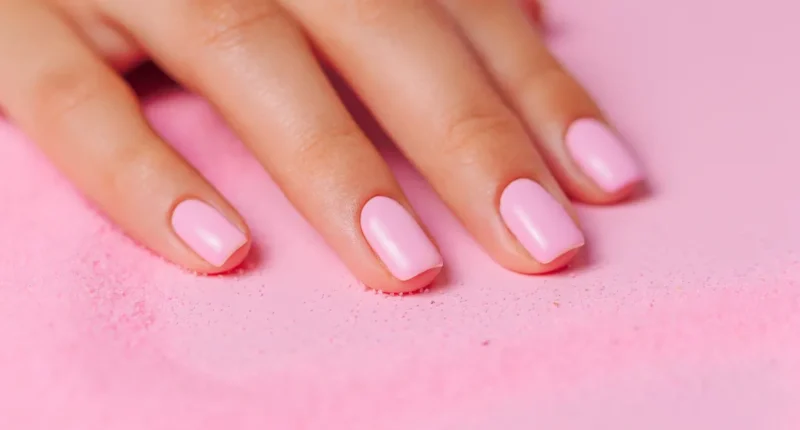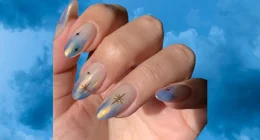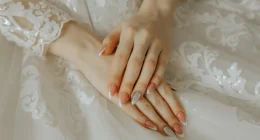Table of Contents Show
Dip powder nails are a popular choice for many people who want a long-lasting, durable, and chip-free manicure. But what are dip powder nails exactly, and how do they compare to other types of nail enhancements? In this blog post, I will explain what dip powder nails are, how they work, and what are their pros and cons according to the dermatologist. I will also share some tips on how to keep your nails healthy and avoid potential problems with dip powder nails.
01 | What are dip powder nails?
Dip powder nails are a hybrid between gel nail polish and acrylic extensions that involve “dipping” the nail into a carton of pigmented powder. The powder is then topped with a clear sealant for a longer-lasting manicure. Board-certified dermatologist and nail expert Dr. Dana Stern adds to this, noting that dip powder nails, while currently trendy, aren’t some new-fangled nail technique. Rather, they’ve been around since the ’80s and are comprised of a gentle yet effective glue paired with acrylic powder.
02 | How do dip powder nails work?
Whether you’re getting your nails done at the salon or doing them yourself at home, the process takes special care and attention. Each salon varies slightly in technique, but you can expect the following steps to be true of most nail salons (and at-home dip powder kits):
- The nails are prepped: “Before starting any manicure, you must ensure the nails are prepped by cleaning and freeing the nail plate of any dirt and oils,” says Syreeta Aaron, a nail artist and LeChat Nails educator. This is also where you should push your cuticles back, clip any hangnails, and buff the surface of the nail plate.
- Bonder is applied: Once you’ve cleaned and prepped your nails, Aaron says you may apply a bonder so that the product can adhere to the nail plate and lessen the chance of lifting.
- Base and powder are applied: “Brush on the base just as if you were polishing your nails,” Aaron instructs, noting to go one nail at a time. Once you’ve applied the base coat to a single nail, dip the nail in the dipping tray of powder and repeat on each nail, brushing off any excess. You may want to re-dip your nails two to three times based on your desired opacity and color intensity.
- Activator is applied: After you’ve dipped all your nails in the powder, Aaron says you need to apply an activator to harden the product and make it ready for filing and shaping.
- Nails are filed and shaped: Using a file or an electric drill, Aaron says you need to shape your nails to your desired length and style. You also need to buff the surface of your nails to smooth out any bumps or ridges.
- Top coat is applied: To seal in your manicure and add shine, Aaron says you need to apply two coats of top coat, letting each one dry for a few seconds.
- Cuticle oil is applied: To moisturize your cuticles and prevent them from drying out, Aaron says you need to apply cuticle oil after your top coat is dry.
03 | What are the benefits of dip powder nails?
Dip powder nails have several advantages over other types of nail enhancements, such as:
- Last longer: Dip powder nails can last up to four weeks without chipping or peeling, which is longer than gel or regular polish.
- Stronger: Dip powder nails are more resistant to cracks, breaks, or splits than gel or acrylic nails.
- Thinner: Dip powder nails are thinner than acrylic nails, which makes them look more natural and feel lighter on your fingers.
- They are odorless: Dip powder nails do not have the strong smell that acrylic nails have, which can be unpleasant for some people.
- Easy to remove: Dip powder nails can be removed by soaking them in acetone for 10 to 15 minutes, without damaging your natural nails.
04 | What are the drawbacks of dip powder nails?
Dip powder nails are not without their disadvantages, however. Some of the potential problems with dip powder nails include:
- They can cause infections: When you dip your nails into a container that other people have dipped their fingers into, you can pick up bacteria and other germs from them. This can lead to serious nail infections or warts. To avoid this risk, you should ask your nail technician to use disposable containers or sprinkle the powder onto your nails instead of dipping them.
- They can cause allergic reactions: Some people may develop an allergic reaction to the adhesives or the powders used in dip powder nails. This can cause swelling, itching, or discolored skin around the nails. If you notice any signs of an allergic reaction, you should stop using dip powder nails and see a dermatologist.
- They can damage your natural nails: Dip powder nails can make your natural nails thinner, weaker, and more prone to peeling or breaking. This is because the nail plate is buffed before applying the product, which removes some of the protective layers of your nails. To prevent this damage, you should avoid buffing your nails too much, use a nail strengthener, and take breaks from dip powder nails every few weeks.
05 | How do dip powder nails compare to gel and acrylic nails?
Dip powder nails are similar to gel and acrylic nails in that they are all types of nail enhancements that add length, color, and durability to your natural nails. However, they also have some differences that may make one more suitable for you than the others. Here is a brief comparison of dip powder nails vs. gel nails vs. acrylic nails:
- Gel nails: Gel nails are made of a gel-like substance that is cured under a UV or LED light. Gel nails are shiny, flexible, and easy to apply and remove. However, gel nails can also chip, peel, or lift more easily than dip powder or acrylic nails. Gel nails can also expose you to UV radiation, which can increase your risk of skin cancer.
- Acrylic nails: Acrylic nails are made of a liquid and a powder that is mixed and applied to your natural nails with a brush. Acrylic nails are hard, durable, and customizable. However, acrylic nails can also look thick, unnatural, and heavy on your fingers. Acrylic nails can also emit a strong odor, damage your natural nails, and cause infections or allergic reactions.
- Dip powder nails: Dip powder nails are made of a glue and powder that are applied to your natural nails by dipping them into a container or sprinkling the powder onto them. Dip powder nails are long-lasting, strong, and thin. However, dip powder nails can also cause infections or allergic reactions, damage your natural nails, and be difficult to apply evenly.
06 | How to keep your dip powder nails healthy
If you decide to get dip powder nails, you should follow some tips to keep your nails healthy and avoid potential problems. Here are some of the best practices for dip powder nail care:
- Choose a reputable salon or nail technician: Make sure you go to a salon or nail technician that follows proper hygiene and sanitation standards. Ask them how they apply the powders and how they clean their tools and containers. Avoid salons or nail technicians that cut or push back your cuticles, double dip your fingers into the powders, or use harsh chemicals on your nails.
- Moisturize your cuticles: Cuticle oil is essential for keeping your cuticles hydrated and preventing them from cracking or peeling. Apply cuticle oil daily after your manicure and before going to bed.
- Wear gloves: When doing household chores or gardening, wear gloves to protect your dip powder nails from water, chemicals, or dirt that can weaken them or cause them to lift.
- Be gentle with your nails: Avoid biting, picking, or peeling your dip powder nails as this can damage them and your natural nails. Use a nail file or clipper to trim or shape your dip powder nails if needed.
- Remove your dip powder nails properly: When you want to remove your dip powder nails, do not peel them off or force them off with a tool as this can harm your natural nails. Instead, soak them in acetone for 10 to 15 minutes until they dissolve completely. You can also use an electric drill to file off the top layer of the product before soaking them.

07 | Conclusion
Dip powder nails are a great option for anyone who wants a long-lasting, durable, and natural-looking manicure. However, they also have some drawbacks that you should be aware of before getting them. To enjoy the benefits of dip powder nails without compromising your nail health, you should follow the tips in this blog post and consult with a professional manicurist.
I hope you found this blog post helpful and informative. If you have any questions or comments about dip powder nails, feel free to leave them below. If you liked this blog post, please share it with your friends and family who might be interested in dip powder nails.
Thank you for reading!
Related Articles:
Dip Powder Nails 101: Everything You Need to Know
Sources:










